Emergency Preparedness Guide
These guidelines are for responding to emergencies at Minnesota State University Moorhead. Not all emergencies fall within the parameters of a defined plan; sometimes individual judgment will be your best guide. Your preparedness, awareness and self-discipline are keys to an orderly and safe emergency response. The guide is also available in PDF version for printing.
There are two basic procedures to follow during a building emergency: evacuation or relocation.
Emergencies involving probable evacuation are:
- Fire, flame or smoke
- Floods
- Bomb threats
Other emergencies that may require only relocation to safe areas within the interior of the building are:
- Weather related
- Utilities failure
- Medical, accidental or health
- Hazardous material release
- Civil disturbances
- Bomb threats
- Hostage situations
NOTE: Building or department-specific information may differ from the details offered in this guide. Refer to the Emergency Plans posted in classrooms, meeting areas, departments and residence halls. For further information contact:
- Public Safety Director, 218.477.5869
- Public Safety Supervisors, 218.477.4276
- Trisha Giddings, 218.477.2449 or trisha.giddings@mnstate.edu
To report any police, fire, or medical emergency, call:
From campus: 911; Public Safety at 218.477.2449
Off campus or from a cell phone: 911 AND Public Safety at 218.477.2449
To report any other building emergency, call: (No need for police, fire, medical)
From campus: Public Safety at 218.477.2449
Off campus or from a cell phone: Public Safety at 218.477.2449
When reporting an emergency:
- Stay on the line with the dispatcher.
- Provide the address of the building involved and your exact location. This is especially critical if you are calling from a cell phone.
- Provide a thorough description of the incident to ensure that proper resources are dispatched.
- Do not hang up until the dispatcher tells you to do so.
Dragon Alert is how the university shares important information about campus closures and MSUM/neighborhood emergencies. During an emergency or campus closure, university officials will send communication to students, employees and registered community members with the location, specific emergency and recommended safety measures. Message(s) will be brief.
Current Students & Employees
First-time Moorhead students and employees must first claim their Dragon Alert account before logging in and adding additional contact details like phone numbers or email addresses.
- Navigate to the Dragon Alert Portal.
- Enter your StarID (ab1234cd).
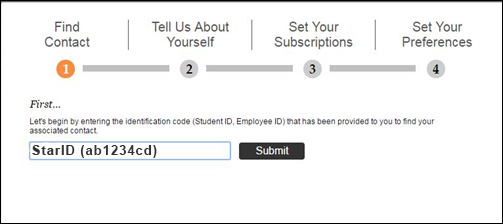
- Click the Submit button.
- After clicking the Submit button, you'll be taken to the next step.
- Enter your Moorhead email address:
- Students: first.last@go.mnstate.edu
- Employees: first.last@mnstate.edu
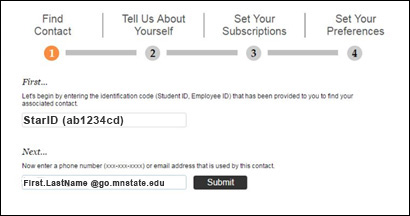
- Click the Submit button.
- After clicking the Submit button, you'll be taken to the next step.
- Your should receive a message above the Associate button that your account has been found.
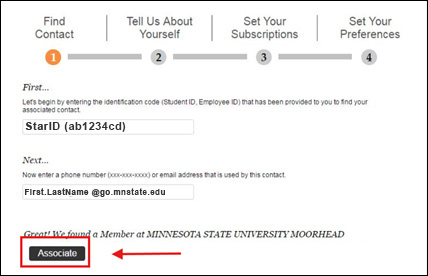
- Click the Associate button.
- After clicking the Associate button, you'll be taken to the next step.
- Click the YES, this is mine checkbox.

- After you click the YES, this is mine checkbox, you'll be taken to the next step.
- Add any additional contact information to your account and click Next.
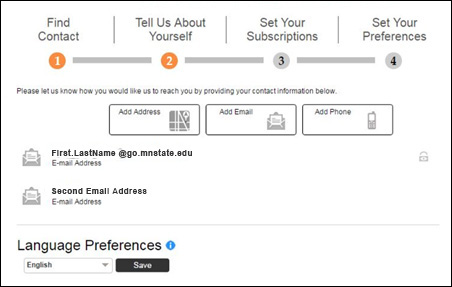
- The next screen verifies your notifications, leave the default option and click Next.
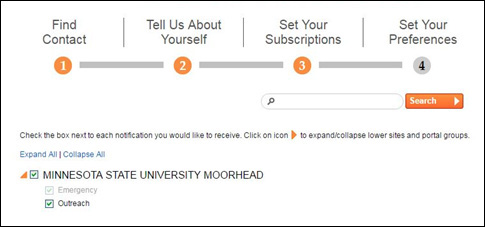
- The final screen will give you information about your notifications preferences. You can close the browser.
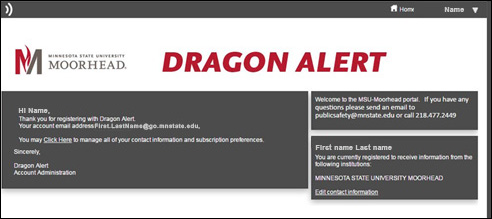
- The next time you go to the Dragon Alert Portal you will log in with your StarID email and password.
- Students: StarID@go.minnstate.edu
- Employees: StarID@minnstate.edu

If you have any issues claiming your account, please contact the IT Help Desk.
Students and employees automatically receive Dragon Alert notifications on their Minnesota State Moorhead official email accounts.
If you would like to receive emergency notifications via text message, voicemail and/or to other email accounts, follow these directions:
- Decide how you want to receive important emergency alerts – text, voice call and/or other personal email accounts.
- Go to the Dragon Alert Portal.
- Go to the Dragon Alert Portal.
- Log in with your StarID and password.
- View and add your contact preferences, which may include cell or work numbers for voice and text, as well as additional email accounts.
Students and employees automatically receive Dragon Alert notifications on their Moorhead official email accounts. By viewing and adding your contact preferences, you will get important and timely information how you want to receive it.
If you have any questions, please send an email to dragonalert@mnstate.edu or call 218.477.2449.
Neighbors & Non-MSUM Students & Employees
Dragon Alert can also share information with our neighbors and non-Minnesota State Moorhead students and employees who do not work or attend on campus.
New Users: To receive university alerts, please complete the Dragon Alert sign-up form below or contact Public Safety.
If you have any questions, please send an email to dragonalert@mnstate.edu or call 218.477.2449.
Dragon Alert can also share information with our neighbors and non-Minnesota State Moorhead students and employees who do not work or attend on campus.
Existing Users: To request updates or changes in Dragon Alert, please complete the Dragon Alert Existing Users Form below or contact Public Safety.
If you have any questions, please send an email to dragonalert@mnstate.edu or call 218.477.2449.
If you have any questions please send an email to dragonalert@mnstate.edu or call 218.477.2449.
If you witness a crime:
- If you witness a crime or become the victim of a crime, call 911 to report the incident to Moorhead Police.
- If you observe a person commit a crime, do not block their avenue of escape. Instead, get a good description of the person, note their direction of travel, and obtain vehicle information if pertinent.
- Do not follow the person. Let the person leave the scene. If followed, the person may panic and cause you harm.
Personal safety tips:
- Do not let people into a locked building or office unless you work with them or they have been properly identified. If the person gives you any problems, call Public Safety (218.477.2449).
- In the event that a suspicious person is seen roaming around, or suspicious calls are received, contact Public Safety immediately.
- Always keep the door to your office/room locked when you are working alone.
- Don’t investigate a suspicious person or noise outside by yourself.
- Keep a list of emergency numbers with you.
- Never walk alone at night. Let someone know where you are going. Walk in an alert and confident manner, and actively pay attention to your surroundings.
- Be alert. If you are being followed, head quickly to a lighted area, building or group of people.
- Choose the best lit, most traveled paths when walking. Avoid walking or jogging alone at night, particularly in isolated area with limited lighting.
- Do not prop open exterior doors that are supposed to be locked.
- Call Public Safety (218.477.2449) for a Safety Escort, available 24 hours a day.
Resource information:
- Emergency: 911
- Public Safety non-emergency: 218.477.2449
- Red River Regional Dispatch Center non-emergency: 701.451.7660
- Safety Escorts: 218.477.2449
Civil disturbances include riots, demonstrations, threatening individuals, or assemblies that have become significantly disruptive.
In the event of a civil disturbance:
- Call Public Safety (218.477.2449)
- Provide the address, location, and all possible details to the dispatcher.
- Do not provoke or become involved in the disturbance.
- Secure your work area, log off computers, and secure sensitive files, if safe to do so.
- If the disturbance is outside, stay away from doors and windows. Remain inside.
If you are to ever find yourself in the middle of an active shooter event, your survival may depend on whether you have a plan. The plan doesn’t have to be complicated. There are three things you could do that make a difference: Run. Hide. Fight.
Run
- When an active shooter is in your vicinity:
- If there is an escape path, attempt to evacuate.
- Evacuate whether others agree to or not.
- Leave your belongings behind.
- Help others escape if possible.
- Prevent others from entering the area.
- Call 9-1-1 when you are safe.
Hide
- If an evacuation is not possible, find a place to hide.
- Lock and/or blockade the door.
- Silence your cell phone.
- Hide behind large objects.
- Remain very quiet.
- Your hiding place should:
- Be out of the shooter’s view.
- Provide protection if shots are fired in your direction.
- Not trap or restrict your options for movement.
Fight
- As a last resort, and only if your life is in danger:
- Attempt to incapacitate the shooter.
- Act with physical aggression and yell.
- Improvise weapons.
- Commit to your actions.
- Survive by any means necessary.
- 9-1-1
- When law enforcement arrives:
- Remain calm and follow instructions.
- Keep your hands visible at all times.
- Avoid pointing or yelling.
- Know that help for the injured is on its way.
Run. Hide. Fight. is a 4 1/2-minute video recommended by the FBI to help you plan for what you can and should do in an active aggressor situation. MSUM’s response to an active aggressor situation would be varied based on the specific circumstances, but this video contains options for you to personally consider if you are ever faced with such an event on campus or elsewhere. Warning: the video includes a simulation of an active shooter event. In an emergency, having thought even once about what you would do can make an important difference in how you will react.
What to Expect from Responding Police Officers
When officers arrive, be prepared to calmly, quickly, and accurately tell them what they need to know:
- location of the shooter
- number of the shooters, if there’s more than one
- description of the shooter 4. number and kinds of weapons they have.
Follow the officers’ instructions. Officers will take command of the situation by shouting orders and/or physically directing individuals to a safe place or the ground.
The first responding officers’ main objective is to stop the active shooter and create a safe environment for medical help for the injured. Officers who arrive later will help identify victims that need medical care and conduct interviews and counseling.
Notice Concerning Behavior?
It is the University’s goal to prevent any unsafe situations before they happen, so we encourage you to report all suspicious behavior and concerns as soon as you notice them. If you experience any immediate threats to your safety or the safety of others, call 911. If you notice concerning behaviors in a friend, coworker, or classmate, call MSUM Public Safety at 218.477.2449.
Note:
- Understand that gunfire may sound artificial. Assume that any popping sound is gunfire.
- If there are two or more persons in the same place when a violent incident begins, spread out in the room to avoid offering the aggressor an easy target.
- Be mindful that violent attacks can involve any type of weapon, not just a gun. Knives, blunt objects, physical force or explosives can be just as deadly as a gun. The suggested actions provided here are applicable in any violent encounter.
If you are involved with or observe a hazardous material (biological, chemical, fuel, or oil) spill, incident, or release for which assistance is needed:
- If the incident is indoors, close and lock all doors in order to isolate the area.
- If possible, open windows to outside.
- Establish exhaust ventilation, if possible. Vent fumes to outside of building.
- Place barricades and warning notices at access points. Post staff by commonly used entrances to direct people to other routes.
- From a safe area, call Public Safety (218.477.2449).
- Be prepared to provide the following information regarding the spill or release:
- Name of the material
- Quantity of material
- Time of the incident
- Location of the incident
- If anyone is injured or exposed to material
- If a fire or explosion is involved
- Your name, phone number, and location
- Follow instructions provided by the dispatcher.
- Arrange for someone to meet the emergency responders.
- Evacuate, if necessary. Help those needing assistance. Remain in a Designated Area of Refuge until released by emergency responders.
- Present the Material Safety Data Sheet of involved substances to emergency responders if this information is available.
Do not attempt to clean up a spill or release unless you are trained to do so and have the proper equipment.
If you are notified of a hazardous materials incident, follow the instructions provided by the emergency response officials:
Clear the area immediately if instructed to do so by the emergency responders, providing assistance to those with special needs.
When evacuating, move crosswind, never directly with or against the wind.
If you observe what you believe to be an unauthorized release of any pollutants to the environment, call Public Safety immediately (218.477.2449).
One of the instructions you may be given in an emergency where hazardous materials may have been released into the atmosphere is to shelter-in-place. This is a precaution aimed to keep you safe while remaining indoors. (This is not the same thing as going to a shelter in case of a storm.) Shelter-in-place means selecting a small, interior room if possible, with no or few windows, and taking refuge there. It does not mean sealing off your entire building. If you are told to shelter-in-place, follow the instructions provided.
Why You Might Need to Shelter-in-Place:
Chemical, biological, or radiological contaminants may be released accidentally or intentionally into the environment. Should this occur, information will be provided by University authorities through the Emergency Notification System.
How to Shelter-in-Place
- Stop classes or work, or close business operations.
- If there are students or visitors in the building, provide for their safety by asking them to stay--not leave. When authorities provide directions to shelter-in-place, they want everyone to take those steps now, where they are, and not drive or walk outdoors.
- Unless there is an imminent threat, ask students, staff, and visitors to call their emergency contact to let them know where they are and that they are safe.
- Close and lock all windows, exterior doors, and any other openings to the outside.
- If you are told there is danger of explosion, close the window shades, blinds, or curtains.
- Select interior room(s) above the ground floor, with the fewest windows or vents. The room(s) should have adequate space for everyone to be able to sit somewhere. Avoid overcrowding by selecting several rooms if necessary.
- It is ideal to have a hard-wired telephone in the room(s) you select. Call emergency contacts and have the phone available if you need to report a life-threatening condition. Cellular telephone equipment may be overwhelmed or damaged during an emergency.
- Bring everyone into the room(s). Shut and lock the door(s).
- Wait for information from the Emergency Notification System to tell you all is safe or to evacuate.
If you receive or discover a suspicious package or mail:
DO NOT TOUCH IT, TAMPER WITH IT, OR MOVE IT!
Immediately call Public Safety (218.477.2449).
*Do not use a cell phone within 300 feet of a suspicious package.
What constitutes a suspicious letter or parcel?
Some typical characteristics which ought to trigger suspicion include letters or parcel that:
- Have any powdery substance on the outside.
- Are unexpected or from someone unfamiliar to you.
- Have excessive postage, handwritten or poorly typed address, incorrect titles or titles with no name, or misspellings of common words.
- Are addressed to someone no longer with your organization or are otherwise outdated.
- Have no return address or have one that can’t be verified as legitimate.
- Are of unusual weight, given their size, or are lopsided or oddly shaped.
- Have an unusual amount of tape.
- Are marked with restrictive endorsements, such as “Personal” or “Confidential.”
- Have strange odors or stains.
What to do if you receive a suspicious package or parcel:
- Remain calm.
- Handle with care. Do not shake or bump.
- Isolate it immediately. Seal in a plastic bag if possible or cover with any material.
- Don’t open, smell, touch, or taste.
- Leave the room and close the door so others can’t enter.
- Call Public Safety (218.477.2449).
Tornado Watch means tornadoes are possible in our area. Remain alert for approaching storms, and be prepared to seek shelter.
Tornado Warning means a tornado is imminent or has been indicated by Doppler radar or reported by storm spotters. Move to a pre-designated Severe Weather Safe Area immediately!
Severe Thunderstorm Watch means severe thunderstorms are possible in your area.
Severe Thunderstorm Warning means a severe thunderstorm is imminent or has been indicated by Doppler radar or reported by storm spotters.
Tornado sirens are located on Livingston Lord Library’s roof and sounded when MSUM lies in a tornado’s path. These sirens are intended to be heard outside of buildings and are not designed to be heard inside every building.
What to do during a tornado warning:
When the tornado sirens sound or a tornado has been sighted, go to a safe shelter immediately.
- Move to a building’s pre-designated Severe Weather Safe Area. These locations include lower level interior hallways and rooms away from windows. Assist those with special needs in getting to the safe area.
- Put as many walls as possible between you and the outside. The large brick buildings on campus are of reinforced construction and should provide adequate shelter. Avoid upper level rooms, auditoriums and gymnasiums with large roofs.
- Close doors to rooms with exterior windows. Do NOT use any elevator. Cover your neck and face with folded arms. Stay there until the danger has passed and the “all clear” message is received.
- Get out of vehicles immediately and go to the lowest floor of a sturdy nearby building or a storm shelter.
- If caught outside with no shelter, lie flat in a nearby ditch or depression and cover your head with your hands.
- Never try to outrun a tornado in a car or truck; instead, leave the vehicle immediately for safe shelter. Tornadoes are erratic and move swiftly.
- Watch out for flying debris. Flying debris from tornadoes causes most fatalities and injuries.
Do not call 911 unless you need to report an emergency, such as a fire, medical emergency or severe building damage. 911 lines need to be kept open and available for emergency calls.
Immediately activate the building’s fire alarm system. Evacuate the building unless otherwise notified. Call 911 from any campus phone or call 911 AND Public Safety (218.477.2449) from a cell phone or from off campus.
If you discover a fire:
- Manually activate the building’s fire alarm system.
- Immediately evacuate the building, closing doors and windows behind you.
- Check the doors with the back of your hand before opening; if hot move to alternative exit.
- DO NOT USE THE ELEVATORS.
- Persons operating equipment that poses a hazard if left unattended should, if at all possible, shut down the equipment prior to evacuating.
- Locate those persons with special needs, and provide assistance if possible. Assist those with mobility impairments to the nearest Area of Safe Rescue. Provide their location to emergency responders.
- Report to your building’s Designated Assembly Area and be accounted for.
- DO NOT re-enter the building until the fire department has cleared the scene.
If caught in smoke:
- Do not breathe the smoke!
- Drop to your knees and crawl to the closest safe exit.
- Breathe through your nose, and use a shirt or towel to breathe through, if possible.
If trapped in a building:
- Close all doors and windows.
- Wet and place cloth material around and under the door to prevent smoke from entering.
- Attempt to signal people outside of the building. Call for help using a telephone or cell phone.
Fire Extinguisher Use
- Report the fire first (Call 911 from any campus phone or call 911 AND Public Safety (218.477.2449) from a cell phone or off campus).
- Use a fire extinguisher only if you have been trained to do so. Improper use of an extinguisher can increase the hazard.
- If you have any doubt of your ability to fight the fire, exit immediately.
- If you decide to use a fire extinguisher, place yourself between the fire and your exit from the area.
- To use the fire extinguisher, follow the PASS method.
- Pull the pin. This will break the tamper seal if one is provided.
- Aim low, pointing the extinguisher nozzle (or the horn or hose) at the base of the fire.
- Squeeze the handle to release the extinguishing agent.
- Sweep from side to side at the base of the fire until the fire is out. Watch the area. If the fire re-ignites, repeat the steps above.
Cardiopulmonary Resuscitation (CPR)
If you suspect a head or spinal injury, DO NOT MOVE the victim unless there is an immediately life-threatening emergency.
- Assess the situation:
- Check the scene. Is it safe for you to proceed?
- Is the person conscious or unconscious?
- If the person appears unconscious, tap or shake their shoulder and ask loudly, “Are you OK?”
- If the person doesn’t respond, follow the steps below and call 911 or have a bystander call 911.
- Locate an Automatic External Defibrillator (AED) if one is immediately available. The closest AED location is indicated on the building’s posted Emergency Plans.
- Use the AED as outlined on the device after turning it on.
- Here is a step-by-step guide for the CPR guidelines:
- If not done already, call 911 or ask someone else to do so.
- Try to get the person to respond; if they do not, roll the person on their back.
- Check for breathing. If the person is not breathing, proceed with chest compressions. If the person is breathing, monitor the person until professional help arrives.
- Start chest compressions. Place the heel of your hand on the person’s sternum (breastbone) at the center of the victim’s chest. Put your other hand on top of the first with your fingers interlaced.
- Press down so you compress the chest at least 2 inches in adults and children and 1.5 inches in infants. Perform compressions. At least one hundred times a minute is optimal.
- If you have not been trained in CPR, continue with chest compressions only until professional help arrives, or the person recovers.
- If you have been trained in CPR, you can now proceed as you were trained by opening the airway with a head tilt/chin lift after completing 30 compressions.
- Pinch the nose closed. Take a normal breath, cover the victim’s mouth with yours to create an airtight seal, and then give two, one-second breaths as you watch for the chest to rise.
- Continue compressions and breaths – 30 compressions, two breaths – until help arrives.
To Control Bleeding
- Have the injured person lie down. If possible, position the person’s head slightly lower then the trunk or elevate the legs. This position reduces the risk of fainting by increasing blood flow to the brain. If also possible, elevate the site of bleeding.
- Remove any obvious dirt or debris from the wound. Don’t remove any large or more deeply embedded objects. Don’t probe the wound or attempt to clean it at this point. Your principal concern is to stop the bleeding.
- Apply pressure directly on the wound. Use a sterile bandage, clean cloth, or even a piece of clothing. If nothing else is available, use your protected hand or have the victim use their hand to apply direct pressure on the wound.
- Maintain pressure until the bleeding stops. When it does, bind the wound tightly with a bandage (or even a piece of clean clothing) and adhesive tape.
- Don’t remove the gauze or bandage. If the bleeding continues and seeps through the gauze or other material you are holding on the wound, don’t remove it. Instead, add more absorbent material on top of it.
- Squeeze a main artery if necessary. If the bleeding doesn’t stop with direct pressure, apply pressure to the artery delivering blood to the area of the wound. Pressure points of the arm are on the inside of the arm just above the elbow and just below the armpit. Pressure points of the leg are just behind the knee and in the groin. Squeeze the main artery in these areas against the bone. Keep your fingers flat. With your other hand, continue to exert pressure on the wound itself.
- Immobilize the injured body part once the bleeding has stopped. Leave the bandages in place and wait for emergency medical service to arrive.
Chemical Burns
If a chemical burns the skin, follow these steps:
- Remove the cause of the burn by flushing the chemicals off the skin surface with cool, running water for 20 minutes or more. If the burning chemical is a powder-like substance such as lime, brush it off the skin without exposing yourself before flushing.
- Remove clothing or jewelry that has been contaminated by the chemical.
- Wrap the burned area with a dry, sterile dressing or a clean cloth.
- Rinse the burn again for several more minutes if the victim complains of increased burning after the initial washing.
Minor chemical burns usually heal without further treatment.
You may not feel any effect from chemical spills, but it’s very important to wash quickly and thoroughly. Many chemicals can cause severe tissue damage that is not apparent until hours later.
Seek emergency medical assistance if:
- The victim has signs of shock, such as fainting, pale complexion, or breathing in a notably shallow manner.
- The chemical burned through the first layer of skin and the resulting second-degree burn covers an area more than 2 to 3 inches in diameter.
- The chemical burn occurred on the eye, hands, feet, face, groin, or buttocks or over a major joint.
If you’re unsure whether a substance is toxic, call the poison control center at (800) 222-1222. If you seek emergency assistance, bring the chemical container or a complete description of the substance with you for identification.
Flooding can occur due to major rainstorms, water main breaks, or loss of power to sump pumps.
In Case of Imminent or Actual Flooding:
- Contact Public Safety (218.477.2449) and report the incident.
- If you can do so safely:
- Secure vital equipment, records, and hazardous materials by moving to higher, safer ground.
- Shut off all non-essential electrical equipment.
- Wait for instructions from Public Safety or Physical Plant.
- Move all personnel to a safe area, away from the building in danger. Locate those persons with special needs, and provide assistance if possible. Otherwise, provide their location to emergency responders.
- Do not return to the building until instructed to do so by Public Safety or Physical Plant.
- Call the Physical Plant (218-477-2662) for assistance with flood clean-up.
Gas Leak - Fumes - Vapors
If you detect natural gas, fumes or vapors:
- Call Public Safety (218.477.2449).
- Clear the area immediately if instructed to do so by the dispatcher, providing assistance to those with special needs.
- Provide your location, the location of the odor, and as many details as possible to the dispatcher.
If a building or area evacuation is ordered by the emergency responders:
- Leave all ventilation systems operating unless instructed otherwise by emergency responders.
- Leave the area immediately, avoiding the use of elevators unless necessary.
- Identify those persons with special needs, and provide assistance if possible. Otherwise, provide their location to emergency responders.
- Report to your building’s Designated Assembly Area to be accounted for.
Power Outage
In the event of a power outage, many campus buildings are supplied with emergency power and/or generators to power critical operations. Most facilities are provided with emergency lighting to aid in the safe evacuation of the building.
To report a localized power outage, contact the Physical Plant (218.477.2662) during business hours or Public Safety (218.477.2449).
Be prepared:
Keep a flashlight with spare batteries immediately accessible.
Know how to locate the closest exit.
In the event of a large-scale power outage:
- Remain calm.
- If building evacuation becomes necessary, seek out persons with special needs and provide assistance, if possible.
- Secure all vital equipment, records, experiments, and hazardous materials if safe to do so. Store all chemicals in their original or marked containers and fully open all fume hoods. If this is not possible, or natural ventilation is not adequate, evacuate the area until power is restored.
- Do not light candles or other types of flames for lighting.
- Unplug electrical equipment, including computers, and turn off the light switches.
If people are trapped in an elevator:
- If you are able to communicate with them, let the passengers know help has been summoned.
- Call Public Safety (218.477.2449).
- Provide specific location information and number of individuals involved to the dispatcher.
- Stay near the passengers if safe to do so, until emergency responders are on site and the elevator is identified.
Instructions: Be calm and courteous. LISTEN! Do not interrupt until they stop talking then begin to ask the questions below. If possible attract the attention of a co-worker and indicate to them the nature of the call and have them call Public Safety (218-477-2449).
- Time of Call:
- Length of call:
- Origin of call:
- Internal
- External
- Unknown
- Caller ID#
- Exact words of the caller:
Questions to ask:
- When is the device going to explode?
- Where is the device located?
- What does it look like?
- What kind of a device is it?
- What will cause it to explode?
- Did you place the device?
- Yes
- No
- Why?
- Where are you calling from?
- What is your name/address/phone number?
Information about the call:
Listen carefully to the voice; note whether the caller is a man or woman; pitch, accent, etc. Circle all that apply:
- Calm
- Broken
- Lisp
- Crying
- Accent
- Disguised
- Normal
- Stutter
- Rapid
- Squeaky
- Loud
- Nasal
- Slow
- Quiet
- Giggling
- Excited
- Slurred
- Angry
- Sincere
- Deep
- Stressed
If voice is familiar, whom did it sound like?
Were there any background noises?
Other remarks:
Person receiving the call:
Position:
Department:
Phone #:Ext:
Report call immediately to Public Safety (218.477.2449)
Building Emergency Plans have been installed in classrooms, labs, conference rooms, departmental main offices and residence halls as part of the University’s Emergency Management Plan. The plans are conspicuously located; show emergency exit routes, fire extinguisher locations, and fire alarm pull stations; and are updated as necessary. At the beginning of each semester everyone should review the floor plans in order to direct occupants to the nearest safe exit in case of an actual alarm.
The plans also indicate:
- Designated Assembly Area. The Designated Assembly Area is the location where building occupants should assemble during a building evacuation. Once the evacuated building is considered safe to enter Public Safety or emergency responders will notify occupants to re-enter the facility.
- Area of Safe Rescue for the Disabled. These areas are constructed to provide a higher degree of protection during fires and are checked by the Fire Department upon arrival. Those with mobility impairments should be assisted to the nearest Area of Safe Rescue (usually a stairwell or a room near an elevator) in the building. Doors should be closed and Fire Department notified immediately upon their arrival of disabled person(s) in the safe area.
- Automated External Defibrillator (AED) location. An AED is a small, lightweight device used to assess a person’s heart rhythm. If necessary, it administers an electric shock to restore normal rhythm in victims of sudden cardiac arrest. The AED uses voice prompts, lights, and text messages to guide the rescuer through procedures.
- Severe Weather Safe Area. Designed as safe areas during tornadoes and other severe weather, these locations include interior hallways and rooms away from windows. The large brick buildings on this University campus are of reinforced construction and should provide adequate shelter. Avoid upper level rooms, auditoriums and gymnasiums with large, poorly supported roofs.
- Shelter-in-Place Area. These locations are safe areas when hazardous materials may have been released into the atmosphere. This would most likely occur during a train derailment, semi-truck tanker, or chemical plant accidentally releasing hazardous chemicals into the environment. Should this occur a “shelter-in place” warning will be provided by an emergency notification system. These areas are interior rooms that are above ground level because some chemicals are heavier that air. Other precautionary measures needing to take place are doors and windows being shut and ventilation systems turned off.
Note: All incoming mail delivery to any department or person at MSUM must use 1104 7th Avenue South, Moorhead, MN 56563 as the mailing address. The U.S. Postal Service will not deliver mail to any other address other than that address on the MSUM Campus. The following building addresses are for physical building locations use only and are not for postal use.
Abbreviation
Science Lab Building
Moorhead Police Substation
Buffalo River Site
